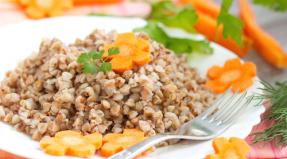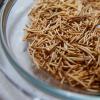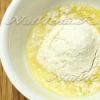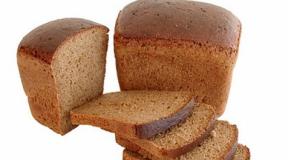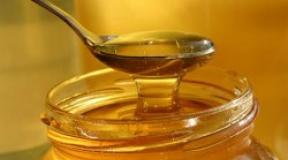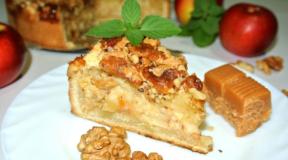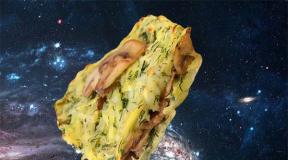What is in ground coffee. The chemical composition of coffee
Julia Vern 37 775 2
Coffee is one of the few drinks of natural origin, consisting of a huge set of various substances, both organic and inorganic origin, significantly affecting almost all structures and systems of the human body.
Freshly brewed sugar-free coffee contains about 1200 natural components, of which more than half are aromatic compounds that determine the taste of the drink.
The taste of the drink is determined by the huge number of volatile compounds that make up its composition.
The chemical composition of coffee
Caffeine belong to the group of alkaloids that excite the activity of the central nervous system. For the first time, caffeine was obtained precisely from coffee beans, which is why it got its name. The tonic effect that increases mental and physical performance is due to caffeine.
According to modern requirements, in the manufacture of coffee, caffeine in it must be at least 0.7%, which directly depends on the degree of maturation of coffee beans and their roasting.
At such a concentration, one teaspoon of freshly ground natural coffee will contain 0.1-0.2 grams of pure caffeine, which is quite enough to obtain an appropriate tonic effect.
It is not recommended to exceed the dose of caffeine above 0.3 grams at a time for 3-4 hours - regular excess of the dosage stimulates the manifestation of increased excitability, sleep disturbances, and increased heart function.
Trigonelline- alkaloid, in its pure form, tasteless and odorless, however, during heat treatment it is converted into pyridine - a substance that gives coffee a specific aroma. Another striking chemical property of trigonelline is its close chemical relationship with niacin (vitamin B3). The niacin molecule is part of trigonelline and is easily released when heated, which ensures a constant amount of vitamin B3 in the drink.
Vitamin B3 plays an important role in the metabolism in the body, stimulates the activity of the nervous system. Lack of this vitamin leads to a disease such as pellagra.
A nicotinic acid is not the only B vitamin found in coffee beans. After appropriate processing of natural coffee, the entire palette of vitamins of this group was found in the drink, as well as:
- the obligatory presence of vitamin A, which is involved in growth and development;
- vitamin D, which improves the absorption of calcium and phosphorus in the intestine;
- vitamin E, which is a participant in the processes of reproduction and a stimulant of the immune system.
Coffee contains a significant amount of complex organic compounds. This proteins and amino acids that perform nutritional and energetic functions for the cells of the body. Coffee beans are one of the rare plant foods that contain essential amino acids that the body gets from meat and fish. Such amino acids are not synthesized in the human body and are involved in the regenerative functions of cellular mechanisms and maintain immunity at a sufficiently high level.

Caffeine molecule structure
Overall volume carbohydrates in raw coffee beans is about 50% of its mass. These energetic substances, valuable for the body, are represented by both simple sugars - sucrose and fructose, and complex polysaccharides - cellulose, fiber, pectin substances, which are an irreplaceable basis for the nutrition of the nerve cells of the brain.
Of the minerals, coffee contains potassium, magnesium and calcium... These inorganic elements are part of the bones, provide muscle work, regulate the work of the heart, blood vessels and brain.
Raw coffee beans contain about 850 different essential compounds, and roasted - about 350, which deservedly awarded the title of the most fragrant drink.
Nutritional value of coffee
Despite such a diverse composition, coffee made from freshly ground natural beans does not have such a high calorie content, which is due to the easy digestibility of the substances that make up its composition. The absorption and digestion process is further stimulated by caffeine, which is also known to be found in coffee drinks.
Depending on the type of coffee and the method of its preparation, its nutritional value per 100 grams of sugar-free product, on average, is:
- proteins, of all types - 0.2 g,
- fats - 0.6 g,
- carbohydrates - 0.1 g,
- calcium - up to 5 mg,
- vitamin B3 - 0.6 mg,
- potassium - 9 mg
- phosphorus - 7 mg
- iron - 2 mg.

Coffee can have both positive and negative effects on the human body.
Impact of coffee on human health
Given the rich chemical composition, coffee has both beneficial and negative, which directly depends on the individual characteristics of a person and the volume of the drink drunk per day. The general picture of the effect of a coffee product on the body is as follows:
- Regular intake of pure caffeine in the amount of more than 1000 mg, of which coffee is the richest, can cause the phenomenon of addiction, similar to drug or alcohol;
- coffee has a sufficient diuretic effect, therefore, if signs of dehydration appear, it is necessary to increase the amount of fluid you drink;
- in healthy people who do not suffer from high blood pressure, coffee causes a general increase in pressure by 10-15 mm Hg. In people suffering from hypertension and related cardiovascular diseases, blood pressure can increase much more or, conversely, decrease, which greatly limits them in coffee drinking;
- no direct effect of caffeine on the heart has been noted. Coffee has an indirect effect on cardiac activity - by increasing blood pressure by stimulating the central nervous system;
- regular use of unfiltered coffee often leads to an increase in total blood cholesterol, which inevitably leads to vascular pathologies, characterizing the appearance of problems with blood pressure;
- improved attention, productivity, memory and mood are temporary. Depending on the reactivity of the organism, a similar effect disappears in 30-120 minutes;
- coffee enhances the effect of some pain relievers, for example, acetylsalicylic acid and analgin, reduces the risk of Parkinson's and Alzheimer's diseases due to a temporary vasoconstrictor effect and a direct effect on the neurons of the brain, the so-called "training" effect of these organs occurs;
- regular coffee consumption reduces the risk of constipation and cirrhosis of the liver, breast cancer in women;
- in the elderly, coffee reduces the density of skeletal bones, which can cause cracks and fractures;
- people who drink more than two cups of coffee a day have a high possibility of developing urolithiasis;
- pregnant women are advised not to drink more than a cup of coffee a day. Due to an increase in blood pressure, due to exposure to caffeine, it is possible to develop placenta anemia, premature birth and low birth weight, as well as miscarriages and stillbirth.
Advantages and disadvantages of instant coffee
The production of instant coffee involves brewing coffee beans, making a coffee beverage and then drying it. In this case, there is an intensive release of all soluble elements contained in coffee beans, and their re-placement in the finished mass of soluble substance, which cannot but be accompanied by losses. Therefore, the main disadvantage of instant coffee is the loss of some valuable nutrients (vitamins, essential amino acids, proteins) and the weakening of the aroma as a result of the evaporation of essential oils. Also, instant coffee has a more obvious bitter taste.

Instant coffee contains fewer nutrients than ground coffee
Manufacturers are trying to compensate for the losses by adding these substances to the finished product, which inevitably leads to higher prices. Therefore, the cheaper the coffee on the counter, the poorer its taste and aroma. In addition, in the manufacture of instant coffee, waste of natural coffee production is used, more often from rejected beans.
Perhaps the only advantage of instant coffee is the speed of preparation and an increase in its shelf life.
The taste of coffee depends on the variety, quality, growing conditions and processing of coffee beans. 4 types of coffee are grown on an industrial scale: arabica, robusta, liberica and excelsa. The most delicious and aromatic, and therefore the most expensive, is Arabica. True, in recent years, new varieties have appeared from the so-called "Ethiopian heritage" - wild-growing types of coffee. They are considered promising, but the best ones, for example Geisha, come from Arabica.
The fruits of the coffee tree are called berries (in the English tradition - cherries). In all types of coffee, the berries have the same structure and differ from each other only in size, thickness of the peel or parchment shell, and color.

The berry most often contains 2 grains. Ripe berries, depending on the type of coffee tree, turn red or yellow. As it ripens, the pulp acquires an increasingly sweet taste. The pulp contains caffeine (although it is much less than in grains), from which an invigorating drink is obtained - cascara.
The structure of the coffee berry:
- The outer shell of the berry is the peel.
- Under the skin is the pulp (pulp).
- A layer of gluten separates the pulp from the shells of the kernels. While the berries are green, this layer is hard, but as it ripens, it softens and becomes very sticky.
- A dense parchment shell is located under the gluten.
- The coffee bean is surrounded by a thin, silvery shell that flakes off when roasted.

The grain ripens together with the pulp, feeds on the useful substances contained in it, acquires sweetness. Therefore, grains are valued only from ripe berries. If the berries are not ripe or overripe, the grains are considered defective.
Peaberry coffee
As a result of mutation, up to 5% of coffee berries contain not two, but only one grain, called (peaberry in translation from English - "pea"). Sometimes it is mistakenly believed that it is two grains grown together. This is not so: when two grains grow together, a hollow ball is obtained, which can be easily divided into two concave halves. Such grains are considered defective, the defect is called "elephant ears".
The process of forming a peaberry is completely different. In a normal ovary, there are always two tiny grains. However, in mutated berries, the development of one grain stops, but the other increases significantly in size: after all, it gets all the nutrients that nature has provided for two seeds.

The coffee brewed from peaberry has a brighter taste and an intense aroma. Gourmet cafes are opening in Western Europe, the United States and Australia, where coffee is made exclusively from peaberry.
It has been noted that most of the peaberry is formed on plantations that do not use mineral fertilizers. For example, in Tanzania, up to 10% of Arabica is peaberry. Taking advantage of the highly prized value of this unusual coffee, Tanzanian farmers hand-select peaberry beans and sell them for much more than regular Arabica beans.
In Latin America, the peaberry is called caracol ("snail") or perla (pearl). Thanks to the use of modern technologies, 2-3 tons of coffee are harvested here from one hectare (while in Tanzania - 300 kg). Therefore, Latin American farmers often do not see the point in manually sorting coffee to separate the peaberry.
The chemical composition of coffee beans
The composition of coffee beans contains more than 100 chemical compounds. Many of them decompose during roasting, forming substances that affect the taste and aroma of coffee.
Substances affecting the properties of coffee as a beverage:
- caffeine is an alkaloid that acts as an energy drink. Robusta has more caffeine than Arabica;
- trigonelline is an alkaloid that breaks down when heated to form nicotinic acid. The decomposition products of trigonelline react to form substances that create a pleasant aroma of roasted grains;
- carbohydrates, in particular monosaccharides (glucose, fructose, lactose, sucrose), which give the drink a sweet taste. In arabica - 8.2–8.3% of sugars, in robusta - 3.3–4.1%. The brown color of roasted coffee beans is a result of caramelization of sugars during heat treatment;
- fats - decompose when heated, forming acids. It is because of the presence of fats that roasted coffee acquires a rancid smell during long-term storage. It is believed that the least fat is found in Indian Arabica;
- organic acids: citric, tartaric, malic, oxalic, coffee. Fruit acids give the drink a sourness: citrus or berry, sometimes with wine notes. If there is an unpleasant aftertaste of vinegar in the drink, it means that the grains have been fermented for too long, due to which acetic acid has formed in them. This taste is considered a disadvantage. Acids decompose when heated, so there is practically no sourness in dark roasted coffee. If you want to muffle the sourness in light roasted coffee, you need to prepare the drink in a pour-over or brew using the cold-bru method;
- chlorogenic acid (refers to organic acids), which itself does not have a bitter taste. When roasted, it forms chlorogenic acid lactones, which in turn decompose into phenylindanes, which are very bitter substances. Therefore, coffee made from dark roasted beans always tastes more bitter;
- tannins are compounds that give the drink a bitter-tart flavor.

Dependence of coffee taste on climatic conditions
The taste of coffee of the same variety changes depending on the height at which the plantation is located:
- 600–1200 m - tones of earth and grass are sometimes felt in the taste, especially if the grains are dry processed. When processed wet, the taste becomes more pleasant;
- 1200-1800 m - coffee has a nutty, citrus or vanilla-chocolate flavor;
- above 1800 m - floral, berry, fruit shades appear in the taste, sometimes with wine sourness.
Alpine coffee is considered the best. However, harvesting is not easy: the plantations are located in places with difficult terrain, on the slopes of the mountains, where it is impossible to deliver equipment. Therefore, such coffee is harvested by hand and processed especially carefully, otherwise it will not be possible to sell at high prices.

Sizes of coffee beans
To sort the grains, they are sieved through special sieves with cells of different sizes.
Types of coffee by size of beans (green, unroasted beans are measured):
- very fine grain (sieve no. 12, mesh side length - 4.764 mm);
- fine grain (No. 13, 5.161 mm);
- small grain (No. 14, 5.558 mm);
- medium grain (No. 15, 5.955 mm);
- good grain (# 16, 6.352 mm);
- sufficiently large grain (sieve No. 17, 6.749 mm);
- large grain (No. 18, 7.146 mm);
- extra large grain (No. 19, 7.543 mm);
- very large grain (No. 20, more than 8 mm).
The size of the coffee bean does not directly affect the taste of the drink; no modern quality assessment system considers size as a criterion. Sorting is needed only for the correct one. The larger the grain, the more difficult it is to fry it evenly inside and out.

Defects in coffee beans
If the beans are improperly processed or stored in improper conditions, the drink will have an unpleasant taste and aroma. To determine the quality, 300 g of coffee is weighed and the number of beans with defects is counted.
Types of coffee beans defects:
- black grains affected by a fungus (give the drink an unpleasant taste);
- kernels with holes damaged by insects;
- concave grains of irregular shape, resembling shells. They tend to have low acidity;
- oily grains. The defect occurs due to the low iron content in the soil. The taste of the drink will be mild;
- Quakers are shriveled kernels made from unripe berries. The coffee is bitter, the sourness is almost not felt;
- Rust-colored kernels from overripe berries or too long fermentation. The drink has an acetic acid taste;
- broken, cut kernels, often smell bad;
- grains covered with mold;
- shriveled yellow grains that have been dried for too long;
- fragile (crystallized) grains of bluish-gray color. This appearance is obtained due to a too high drying temperature. They make coffee tasteless.
Foreign inclusions are also considered defects: pebbles, leaves, coffee husks.
Raw coffee beans primarily contain caffeine, trigonelline, chlorogenic acid, protein, and mineral salts. This set of substances makes up a quarter of the mass of raw grain. The rest is fiber, coffee oil and water.
Caffeine is a representative of the alkaloids group. It is caffeine that coffee owes its invigorating effect. In its pure form from coffee beans, this caffeine was isolated in the 1920s. Caffeine is in the form of colorless crystals with a bitter taste.
Trigonelline is also an alkaloid found in coffee beans. Unlike caffeine, it does not have an exciting effect on the human body, however, the taste and smell of roasted coffee beans depends on it.
Chlorogenic acid is one of the most valuable components of the composition of coffee beans.
Natural unroasted grain is the only natural product with a high content of chlorogenic acid. By stimulating the work of the human digestive system, chlorogenic acid, which is part of green coffee beans, helps the body break down fats, which is why nutritionists around the world recommend green coffee beans for weight loss. When roasting coffee beans, the content of chlorogenic acid decreases 2-3 times, and coffee acquires a characteristic, slightly astringent taste.
It should be added that coffee beans contain more than 30 different organic acids (including malic, citric, acetic and coffee). In addition, coffee beans contain healthy fatty acids:
- linoleic acid - 52.2-54.3%;
- palmitic - 26.6-27.8%;
- oleic - 6.7-8.2%;
- stearic - 5.6-6.3%;
- arachidonic - 2.6-2.8%;
- linolenic - 2.2-2.6%;
- behenic - 0.5-0.6%.
Despite such an abundance of nutrients, natural grain coffee is not a high-calorie product, although it contains - proteins - 0.2 g, fats - 0.6 g and carbohydrates - 0.1 g from natural grain no more than 1 -2 Kcal. Nicotinic acid and vitamin PP contained in coffee beans are active biological components. That is why coffee is considered low-calorie and incapable of harming a person's figure.
 However, do not forget that the daily portion of coffee made from natural beans should not exceed 0.3 g of caffeine, which corresponds to two teaspoons of ground coffee beans per glass of water, and taking 4 cups of coffee beans per day is 1 g of caffeine, a person develops a constant need in coffee, comparable to alcohol addiction.
However, do not forget that the daily portion of coffee made from natural beans should not exceed 0.3 g of caffeine, which corresponds to two teaspoons of ground coffee beans per glass of water, and taking 4 cups of coffee beans per day is 1 g of caffeine, a person develops a constant need in coffee, comparable to alcohol addiction.
The coffee bean is the seed of the coffee tree, the source of coffee. It is a red or purple seed inside the fruit, which is why coffee beans are often called cherries. Despite the fact that coffee beans are seeds, due to their resemblance to real beans, they are called "beans". Fruits (coffee cherries or berries) most often consist of two parts with flat sides attached to each other. A small percentage of cherries contain one seed instead of the usual two. They are called "peaberry" (rounded coffee beans). Similar to Brazil nuts (seeds) and white rice, coffee seeds are mainly composed of endosperm. The two most economically important coffees are Arabica and Robusta; 75-80% of the coffee produced worldwide is Arabica and 20% Robusta. Arabica seeds contain 0.8-1.4%, and Robusta seeds - 1.7-4%. Since coffee is one of the most widely consumed beverages in the world, coffee seeds are an important export product, contributing over 50% of foreign exchange earnings in some developing countries. The United States imports more coffee than the rest of the country. Per capita coffee consumption in the United States in 2011 was 4.24 kg (9 lb), and coffee imports exceeded $ 8 billion.
Story
In the Americas, coffee first appeared in 1723. South America provides approximately 45% of the world's total coffee exports. Most of this coffee is grown in Brazil.
Significant dates
First coffee cultivation in Europe (also for the first time outside East Africa / Arabia) - 1616 First coffee cultivation in India (Malabar) - late 1600s First coffee cultivation on Java island - 1699 First coffee cultivation in the Caribbean (Cuba, Haiti, Jamaica, Santo Domingo, Puerto Rico) - 1715-1730 First coffee cultivation in South America - 1730 First coffee cultivation in the Dutch East Indies - 1720 First sale of roasted coffee beans in the retail market (Pittsburgh) - 1865 Development of Important Spray Drying Techniques - 1950s
Etymology
The Oxford English Dictionary indicates that European languages generally adopted the word "coffee" from the Turkish word kahveh, around 1600 AD, possibly through the Italian Caffè. The Arabic word qahwah (in Turkish kahveh), the name of an infusion or drink; According to Arabic lexicographers, originally this word meant wine or a certain type of wine, and was derived from the root of the verb qahiya, "to have no appetite." Another common theory is that the name comes from the province of Kaffa, Ethiopia, where the plant may have originated from.
A coffee tree
The coffee tree is on average 5-10 m (16-33 ft) tall. Over the years, the tree has fewer and fewer branches and more leaves and fruits. The coffee trees are planted in rows a few feet apart. Some farmers plant fruit trees around them or plant coffee trees on the sides of the hills because they need specific conditions to grow. Ideally, Arabica coffee seeds are grown between 15-24 ° C (59-75 ° F) and Robusta at 24-30 ° C (75-86 ° F) and 15-30 cm (5.9-11.8 inches) ) precipitation per year. Heavy rain is needed at the beginning of the season when the fruit is developing, and less needed at the end of the season as it is ripe.
Treatment
When fruits ripen, they are most often harvested using the "selective selection" method (picking only ripe fruits) or "strip picking" (collecting all the fruits from the branch at once). On rare occasions, the Asiatic palm marten eats the coffee fruit and excretes the beans. These beans are called Kopi Luwak and are used to make a very rare and expensive coffee. There are two ways to process coffee berries. The first method - "wet processing", is common in Central America and regions of Africa. The pulp of the berries is separated from the seeds, and then the seeds are fermented - soaked in water for about two days. This helps to dissolve the pulp or sticky marks that may still be present on the seeds. The “dry-till” method is cheaper and simpler, and is used to treat lower quality seed in Brazil and much of Africa. Branches and other foreign objects are separated from the berries, and then the fruits are laid out in the sun on concrete or brick for 2-3 weeks. To ensure even drying, the grains are regularly turned over.
The term "green coffee seeds" refers to unroasted, ripe or unripe coffee seeds. They are processed wet or dry, removing the outer pulp and mucus. Such grains have an intact wax layer on the outer surface. Unripe seeds are green. Ripe seeds are brown to yellow or reddish in color. Typically, dried coffee beans weigh between 300 and 330 mg. Non-volatile and volatile compounds found in green coffee seeds, such as those, keep many insects and animals from eating them. In addition, both non-volatile and volatile compounds create a unique coffee aroma when roasting coffee beans. Non-volatile nitrogenous compounds (including alkaloids, trigonelline, proteins and free) and carbohydrates are essential in creating the full aroma of roasted coffee, and play an important role in its biological action. Since the mid-2000s, green coffee extract has been marketed as a dietary supplement and has been clinically tested for its chlorogenic acid content. The lipolytic properties of the extract and its effect on weight loss were also evaluated.
Coffee has a complex chemical composition: it contains approximately two thousand chemicals that together determine its distinctive aroma and taste. Moreover, less than half of these substances have been studied. The most difficult aspect - their effect on the human body - is still waiting for its researchers.
Raw coffee beans contain fats, proteins, water, mineral salts, various water-soluble and insoluble substances.
Taking a coffee drink containing caffeine is a kind of taking a very small dose of medicine, and can therefore be considered as a preventive measure that stimulates and supports the functional activity of certain vital organs of a person. Different types of coffee contain different amounts of caffeine - on average, from 1 to 2 percent.
Caffeine (C8H10N4O2). This substance is colorless and odorless; in one solution it gives a bitter taste. Caffeine crystallizes from aqueous solutions in the form of crystalline hydrate in the form of fragile silky needles. Caffeine anhydrous melts at 236.5ºC and can sublimate if heated gently. It dissolves easily in chloroform, methylene chloride, di- and trichlorethylene. Aqueous solutions of caffeine have a neutral reaction; it forms salts with acids. Caffeine in raw coffee is found in a free state and associated with potassium chloride.
Different types of coffee are characterized by the following caffeine content (% on dry basis):
Arabian - 0.6-1.2
Robusta - 1.8-3
Liberian - 1.2-1.5.
The amount of caffeine in beans varies greatly depending on the type of coffee. The caffeine content of beans plays a very important role in evaluating the quality of raw materials and setting specifications for them.
Another alkaloid found in coffee is trigonelline... Trigonelline (C7H7O2N), or methylbetainicotinic acid, is formed in plants by methylation of nicotinic acid. This alkaloid is found in relatively large quantities in Arabica coffee varieties (1-1.2%). In the varieties of the Caniforma (Robusta) species, it is slightly less (0.6-0.74%), and in the varieties of the Liberica species - only 0.2-0.3%. Trigonelline is highly soluble in water, but thermally unstable. When processed, coffee beans are easily converted into nicotinic acid (vitamin PP), therefore it is considered the main precursor for the formation of nicotinic acid in coffee beans. This alkaloid is not aphrodisiac, but it is essential in the aroma and flavor of roasted coffee.
Also, coffee contains such alkaloids as:
- theobromine ;
Theobromine is dimethylxanthine (C7H8O2N4), since it forms monomethylalloxane and monomethylurea during oxidation. It is a colorless fine-crystalline powder, hardly soluble in water. Theobromine melts at 351ºC, is able to sublimate, easily dissolves in caustic alkalis, giving, for example, sodium salt. The theobromine content in raw coffee beans is insignificant - 1.5-2.5 mg%.
Theophylline;
Theophylline (C7H8O2N4) forms colorless silky needles containing one crystal water molecule. Theophylline is hardly soluble in cold water, melts at 269-272ºC. Its total amount in grains of wild-growing coffee plants is 1-4 mg%. Of the groups of plant substances of secondary origin, glucoside mascaroside (C12H36O11) was found and isolated in a crystalline form in the grains of wild coffee plants. It was found that it is a pentacyclic diterpene glucoside similar in some properties to kafamarin isolated from the beans of cultivated coffee plants C. Buxifolia. No capamarin was found in C. vianneyi beans. Polyamines (putrescine, spermine, spermidine), which form various heterocyclic alkaloids during deamination or oxidation, were isolated and identified from raw grains by thin-layer chromatography.
In addition, coffee contains eight vitamins from the B group, which are of great importance for humans. They regulate the course of many biochemical processes in the body and thus prevent the occurrence of a number of serious diseases.
Organic acids, which are an integral part of coffee beans, are of great value. They cause increased gastric secretion and thus promote good digestion and rapid evacuation of food from the stomach. According to modern data, coffee contains more than 30 organic acids: such widespread acids as malic, citric, acetic, and such rare ones as coffee, chlorogenic, cinchona and others. Most organic acids in green coffee are in the form of salts, metals, and only about 1/3 are in free form.
The most important and predominant organic acid is chlorogenic acid. It appears to impart an astringent flavor and a sense of fullness to the beverage. Its content in coffee of various varieties ranges from 4 to 8%.
Roasted coffee has an even wider variety of substances. During the roasting process, complex physicochemical changes occur, leading to new physical properties, partial decomposition and the formation of new substances that determine the color, taste and aroma of roasted coffee beans.
When roasted, the coffee bean increases in volume by 1.5 times and loses up to 18% of its weight. Loss occurs due to evaporation of moisture and partial decomposition of organic substances: proteins, fats, sugars, fiber, organic acids and other compounds. Caffeine changes slightly during the roasting process. But since the weight of the coffee decreases during roasting, the percentage of caffeine in the roasted coffee even increases slightly.
The chemical changes in coffee during roasting are very complex and not well understood. The complexity of changes in the chemical composition of coffee can be judged at least by the fact that the caffeol (the substance that causes the smell of roasted coffee) contains more than 70 different aromatic substances.
These substances are easily volatile and are quickly oxidized by atmospheric oxygen. Therefore, it is recommended to either roast the coffee just before drinking, or store the roasted coffee for a short time in hermetically sealed glass or tin cans.
Changes in the main components of coffee beans during the roasting process
|
Components | ||
|
fried |
||
|
Soluble substances (amount) | ||
|
Nitrogenous substances | ||
|
Dextrin | ||
|
Cellulose | ||
|
Hemicellulose | ||
|
Ash elements | ||
|
Caffeinated acid | ||
|
Chlorogenic acid (sum of free and bound) | ||
So, the chemical composition of coffee indicates that coffee is not only a gustatory product, but due to the content of fat, sugar and protein substances, it also has good nutritional benefits. An important place in the chemical composition of coffee is the alkaloid caffeine, which has an exciting and stimulating effect on the human body. Moderate consumption of coffee contributes to the maintenance of a vigorous state of the body, increases its efficiency, and improves the general metabolism.
